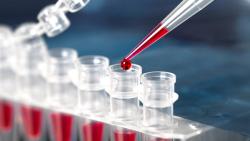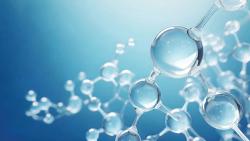
OR WAIT null SECS
- About Us
- Advertise
- Editorial Information
- Contact Us
- Do Not Sell My Personal Information
- Privacy Policy
- Terms and Conditions
© 2024 MJH Life Sciences™ and BioPharm International. All rights reserved.
Bioanalytical Methods for Sample Cleanup
Preparation of biological samples for chromatographic analyses.
High-throughput bioanalytical methods are essential to support the rapid discovery and development of drugs in the pharmaceutical industry. Liquid chromatography coupled with tandem mass spectrometric detection (LC–MS/MS) is considered as the benchmark analytical methodology for quantifying new chemical entities in biological fluids (1–4). Because of the high sensitivity and selectivity of LC–MS/MS, the time required for method development and subsequent sample analysis is dramatically reduced. Rigorous chromatographic resolution of analytes and/or tedious sample extraction protocols are typically not required even when complex biological matrices are used. Most chromatographic techniques have matured and automation is now commonplace (5–7). Nevertheless, with common sample analysis times of less than three minutes, the bottleneck in sample analysis has become the sample preparation step. Sample preparation is still considered to be a slow and labor-intensive process, and it is rare for an analyst to be able to inject samples directly into an LC–MS/MS system with no pretreatment.
Roger N. Hayes
The importance of sample preparation stems from three major concerns—removing interferences from the biological sample matrices, concentrating the analyte(s) of interest, and improving analytical system performance (8). An industry survey noted a marked increase in methods requiring limits of quantitation of less than 1 ppb, and the trend toward trace analyses is not diminishing (9). Optimized sample preparation techniques that provide high enrichment factors become crucial for these dilute concentrations.
The choice of sample preparation method should depend on the quality of the data required. It makes little sense to invest weeks of development time attempting to achieve pg/mL sensitivity for a screening assay. However, it may be important to invest such time to develop and validate a method for a lead drug candidate undergoing human safety assessments that are subject to FDA regulatory scrutiny. Indeed, validating analytical procedures is the process of determining a suitable method that is capable of providing useful analytical data. It is important to bear in mind that a method that is valid in one situation could be invalid in another (10, 11).
In the pharmaceutical industry, the most common biological sample matrix is plasma. Moreover, it is common practice to dilute troublesome matrices like urine or cerebrospinal fluid with plasma and apply previously developed plasma extraction protocols. Drugs are most commonly isolated from plasma using one (or occasionally, a combination) of either liquid–liquid extraction, protein precipitation, or solid phase extraction. Other less common choices include column-switching (LC–LC), affinity extraction, and ultrafiltration.
LIQUID-LIQUID EXTRACTION
Liquid-liquid extraction (LLE) using organic solvents offers sample cleanup with analyte enrichment steps, and is a rugged off-line sample preparation process that is well suited for routine high-throughput LC–MS/MS analysis. The basic concept of LLE is to partition an analyte into a volatile organic solvent away from polar proteins and lipids that remain in an aqueous phase. The organic phase is removed, evaporated, and the sample reconstituted for injection onto an LC–MS/MS system. By careful choice of organic solvent, LLE is amenable to automation in a 96-well format (12–15). In order, the acceptability of solvents for automated LLE is methyl t-butyl ether > 95/5 hexane/ethanol >;>t; ethyl acetate. LLE does, on occasion, suffer from emulsion formation, which may be resolved by extended centrifugation.
LLE can also be performed in the solid state by using diatomaceous earth (Hydromatrix or Celite). Several such products are available commercially for performing supported liquid extractions (SLE) in a 96-well plate format.
PROTEIN PRECIPITATION
Plasma sample preparation by protein precipitation (PPT) is the most widely used technique for LC–MS/MS analysis because of its simplicity, low cost, and universality. PPT is amenable to automation in a 96-well format (16). Precipitation of plasma proteins is most commonly performed by using organic solvents like acetonitrile or methanol. Following denaturation, the sample is centrifuged and the supernatant is directly injected. However, organic solvents are inefficient in precipitating proteins and often require significant dilution of the plasma sample, typically by two- to three-fold. Overcoming the impact of dilution by injecting larger volumes of the plasma extract may be precluded when using reversed-phase HPLC because of the high organic content. Evaporation of the extracted samples to near dryness followed by reconstitution in an appropriate solvent is usually required. In order, the preference of solvent for automated PPT is 95/5 (v/v) acetonitrile/acetone >; acetonitrile >;>; methanol.
Alternative choices for precipitation of plasma proteins include trichloroacetic acid (TCA) or zinc sulfate. Reagents like TCA and zinc sulfate, however, are unable to remove small proteins, polypeptides, and salts, thereby contributing to high ionic strength of the supernatant that can subsequently suppress ionization and attenuate LC–MS/MS response.
Despite the attractiveness of PPT as a rapid approach to sample preparation, potential drawbacks exist. For example, because only proteins are removed, ion suppression from co-eluting matrix components can significantly reduce sensitivity, especially when using electrospray ionization. Therefore, assessing the potential for ion suppression over the elution time is an important step in developing a rugged method. Although using stable isotope-labeled internal standards can compensate for response variability, ultimately such a loss in sensitivity limits the achievable limit of quantification. 96-well filter plates are available commercially and they provide the analyst the ability to conduct, in an automated fashion, the protein crash procedure, the mix step, and the filtration of protein precipitants in the same 96-well flow-through plate.
SOLID-PHASE EXTRACTION
The third alternative to sample cleanup is solid-phase extraction (SPE). SPE methods consist of loading samples onto pre-conditioned sorbent-filled cartridges, often arranged in a 96-well plate format. Loaded samples are then washed with an appropriate solvent, and the analyte(s) is subsequently eluted. Method selection and extract cleanliness are determined by the retention mechanism and the ability of the wash stage to effectively remove endogenous components. For example, ionic interactions, as represented by cation and anion exchange, offer a greater degree of analyte selectivity and, therefore, extract cleanliness when compared to C18-based sorbents. In general, extracts from SPE are cleaner than those from PPT.
SPE gained in popularity because of its compatibility with automation, especially with sorbent material packed into a 96-well format plate (17–18). Technological improvements include the development of polymeric SPE sorbents that no longer suffer from sorbent drying problems while enjoying extended working pH ranges. Taking advantage of the full pH range of the sorbent, a specific pH and organic modulated SPE (i.e., an optimized SPE) method can be developed to provide clean sample extracts. The hydrophilic-hydrophobic nature of these polymeric supports is amenable to generic extraction techniques.
A generic protocol should achieve high recovery; however, high recoveries do not necessarily correlate with high sensitivity in LC–MS/MS. Achieving high sensitivity is usually a trade-off between recovery and chemical interference or ion suppression. Nevertheless, high sensitivity and high recovery are achievable by selective retention of a basic drug using strong cation exchange SPE. Fortunately, the majority of drug candidates have a basic functionality that can be leveraged for selective retention on an appropriate strong cation exchange SPE material.
As described, SPE methods often involve evaporation and subsequent reconstitution of the eluent before LC–MS/MS analysis. These steps not only take time and effort, but can also lead to the loss of valuable sample. Therefore, the ability to elute in very small volumes of solvent is desirable to minimize sample preparation time and reduce sample loss. Low sorbent mass and novel 96-well plate designs, including SPE pipette tips and discs, have alleviated some of these concerns (19).
Another approach to consider is the direct coupling of SPE to the LC–MS/MS system (i.e., on-line SPE) (20). Differences in flow rates during load and elution steps afford additional opportunities to enhance the extraction process. For example, sufficiently high flow rates can induce turbulent flow chromatography that actually involves a combination of size-exclusion and adsorption phenomena (21–24). If the analyte fraction has a high enough affinity for the stationary phase inside the pores, then it will remain there until a solvent with the appropriate strength desorbs it.
Online SPE methods have the potential to significantly enhance sensitivity because no dilution of sample occurs. Eliminating analyte collection, evaporation, reconstitution, and injection not only improves reproducibility, but also saves time, labor, and solvents.
CONCLUSION
The general idea of sample cleanup is that all elements of a method should contribute to its required sensitivity and selectivity. Issues to consider when selecting a bioanalytical method for sample cleanup should include what matrix the analyte is in, the detection limit and dynamic range required, the number of samples to be analyzed, analyte stability to extraction, and the amount of matrix available.
The final method should be orthogonal to maximize selectivity and reduce ion suppression. If C18 SPE is used for sample extraction, then the analyst should consider cation exchange or phenyl column chromatography. Alternatively, if strong cation exchange SPE was selected for sample extraction, then any reverse-phase LC method can be used. The sample cleanup method should be assessed for recovery, selectivity, precision, accuracy, and ruggedness. Formal validation may also be required (25–27).
Roger N. Hayes is vice-president and general manager of laboratory sciences at MPI Research, 54943 North Main Street, Mattawan, MI 49071.
REFERENCES
1. T.R. Covey, E.D. Lee, and J. Henion, Anal. Chem. 58 (12) 2453–2460 (1986).
2. H. Fouda et al., J. Am. Soc. Mass Spectrom. 2, 164–167 (1991).
3. E.C. Huang et al., Anal. Chem. 62, 713–725 (1990).
4. R.S. Plumb et al., Xenobiotica, 31 (8–9), 599–617 (2001).
5. D. Mole, R.J. Mason, and R.D. McDowall, J. Pharm. Biomed. Anal. 11 (3), 183–190 (1993).
6. E. Doyle et al., Anal. Proc. 26, 294–295 (1989).
7. M. Jemal, Biomed. Chromatogr. 14 (6), 422–429 (2000).
8. R.D. McDowall et al., J. Pharm. Biomed. Anal. 7 (9), 1087–1096 (1989).
9. R.E. Majors, LCGC North America, 20, 1098–1113 (2002).
10. B.A. Persson, J. Vessman, and R.D. McDowall, LC-GC Int. 11, 160–164 (1998).
11. B.A. Persson, J. Vessman, and R.D. McDowall, LC-GC Int. 10 (9), 574–576 (1998).
12. N. Zhang, K.L. Hoffman, W. Li, and D.T. Rossi, J. Pharm. Biomed. Anal. 22, 131–138 (2000).
13. Z. Shen, S. Wang, and R. Bakhtiar, Rapid Commun. Mass Spectrom. 16 (5), 332–338 (2002).
14. J. Zweigenbaum et al., Anal. Chem. 71 (13), 2294–2300 (1999).
15. M. Jemal, D. Teitz, Z. Ouyang, and S. Khan, J. Chromatogr. B 732 (2), 501–508 (1999).
16. D. O'Connor, D.E. Clarke, D. Morrison, and A.P. Watt, Rapid Commun. Mass Spectrom., 16 (11), 1065–1071(2002).
17. C. Sottani, C. Minoia, M. D'Incalci, M. Paganini, and M. Zucchetti, Rapid Commun. Mass Spectrom. 12 (5) 251–255 (1998).
18. H. Simpson et al., Rapid Commun. Mass Spectrom., 12 (2) 75–82 (1998).
19. R.E. Majors. New Designs and Formats in Solid-Phase Extraction sample preparation, LCGC Europe 12 (1) 2–6 (2001).
20. F. Beaudry, J.C. Yves Le Blanc, M. Coutu, and N.K. Brown, Rapid Commun. Mass Spectrom 12 (17) 1216–1222 (1998).
21. H.M. Quinn and J.J. Takarewski, "Improvement in Chemical Analyses" International Patent Number WO97/16724 (May, 1997).
22. M. Jemal, Zh. Ouyang, B.C. Chen, and D. Teitz, Rapid Commun. Mass Spectrom. 13 (11) 1003–1015 (1999).
23. J.T. Wu, H. Zeng, M. Qian, B.L. Brogdon, and S.E. Unger, Anal. Chem. 72 (1) 61–67 (2000).
24. M. Jemal, Y. Qing, and D.B. Whigan, Rapid Commun. Mass Spectrom. 12 (19) 1389–1399 (1998).
25. J.R. Kagel, W. Donati, L.E. Elvebak, and J.A. Jersey, Amer. Lab., 33 (24) 20–23 (2001).
26. V.P. Shah et al., Eur. J. Drug Metab. 16 (4) 249–255 (1991).
27. A.R. Buick, et al., J. Pharm. Biomed. Anal. 8 (8–12) 629–637 (1990).



